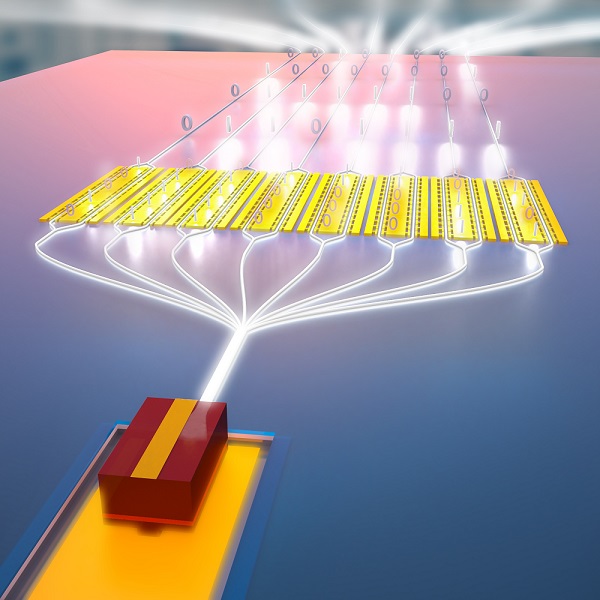
Integrated Laser on Lithium Niobate Chip to Spur Advanced Telecom
In collaboration with industry partners at Freedom Photonics and HyperLight Corp., researchers at the Harvard John A. Paulson School of Engineering and Applied Sciences (SEAS) developed what the collaborators said is the first fully integrated high-power laser on a lithium niobate chip. The technology paves the way for high-powered telecommunications systems, fully integrated spectrometers, optical remote sensing, and efficient frequency conversion for quantum networks, among other applications.
Lithium niobate photonics technologies have seen a number of recent developments, from frequency combs to frequency converters and modulators. But lasers have proved difficult to integrate. An integrated laser would greatly reduce the cost and increase the scalability and stability of long-haul telecommunications networks, data center optical interconnects, and microwave photonics, all of which rely on lasers to generate an optical carrier used in data transmission.

The on-chip laser is combined with a 50-GHz electro-optic modulator in lithium niobate to build a high-power transmitter. Courtesy of Second Bay Studios, Harvard SEAS.
“Integrated lithium niobate photonics is a promising platform for the development of high-performance chip-scale optical systems, but getting a laser onto a lithium niobate chip has proved to be one of the biggest design challenges,” said Marko Loncar, the Tiantsai Lin Professor of Electrical Engineering and Applied Physics at SEAS and senior author of the study. “In this research, we used all the nano-fabrication tricks and techniques learned from previous developments in integrated lithium niobate photonics to overcome those challenges and achieve the goal of integrating a high-powered laser on a thin-film lithium niobate platform.”
Loncar and his team used small but powerful distributed feedback lasers for their integrated chip. The devices are prime candidates for integration with the thin-film lithium niobate modulators due to their small footprint, low cost, and high power output, according to the researchers.
The laser uses a high-power indium phosphide (InP)-based platform, which has demonstrated output powers greater than 300 mW and has reported low relative intensity noise. The laser design ensures minimal free-carrier absorption, a lower voltage drop across the diode, and reduced mirror loss. In turn, this results in a longer cavity length, which yields higher power, lower linewidths, and a reduction in spatial hole burning.
On chip, the lasers sit in small wells or trenches etched into the lithium niobate and deliver up to 60 mW of optical power in the waveguides fabricated in the same platforms. The team combined the laser with a 50-GHz electro-optic modulator in lithium niobate to build a high-power transmitter.
“Integrating high-performance plug-and-play lasers would significantly reduce the cost, complexity, and power consumption of future communication systems,” said Amirhassan Shams-Ansari, a graduate student at SEAS and first author of the study. “It’s a building block that can be integrated into larger optical systems for a range of applications in sensing, lidar, and data telecommunications.”
By combining thin-film lithium niobate devices with high-power lasers using an industry-friendly process, the work represents a key step toward large-scale, low-cost, and high-performance transmitter arrays and optical networks. Next, the team aims to increase the laser’s power and scalability for even more applications.
Harvard’s Office of Technology Development has protected the intellectual property arising from the Loncar Lab’s innovations in lithium niobate systems. Loncar is a co-founder of HyperLight Corp., a startup that was launched to commercialize integrated photonic chips based on certain innovations developed in his lab.
The research was published in Optica (www.doi.org/10.1364/optica.448617).
/Buyers_Guide/Hyperlight_Corp/c33011
/Buyers_Guide/Freedom_Photonics_LLC/c24874